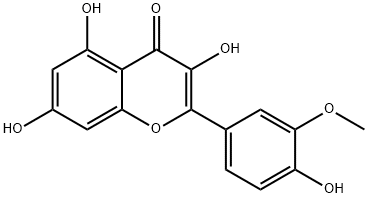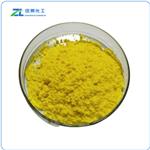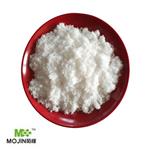Isorhamnetin is a flavonoid, which occurs naturally in plants and it is also a metabolite of quercetin.
Isorhamnetin has anti-inflammatory effect as it can reduce the formation of large amounts of nitric oxide by the inhibition the activation of nuclear factor-κB (NF-κB), which is a significant transcription factor for inducible nitric oxide synthase. Isorhamnetin is also reported to have effect in inducing the expression of neurofilaments, and it potentiated the NGF-induced neurite outgrowth and neurofilament expression, which could be a new direction in searching potential candidates as new drugs or food supplements for neurodegenerative diseases.
[1] Mari Hämäläinen, Riina Nieminen, Pia Vuorela, Marina Heinonen and Eeva Moilanen, Anti-Inflammatory Effects of Flavonoids: Genistein, Kaempferol, Quercetin, and Daidzein Inhibit STAT-1 and NF-κB Activations, Whereas Flavone, Isorhamnetin, Naringenin, and Pelargonidin Inhibit only NF-κB Activation along with Their Inhibitory Effect on iNOS Expression and NO Production in Activated Macrophages, Mediators of Inflammation, 2007, vol. 2007, Article ID 45673
[2] Sherry L. Xu, Roy C. Y. Choi, Kevin Y. Zhu, Ka-Wing Leung, Ava J. Y. Guo, Dan Bi, Hong Xu, David T. W. Lau, Tina T. X. Dong and Karl W. K. Tsim, Isorhamnetin, A Flavonol Aglycone from Ginkgo biloba L., Induces Neuronal Differentiation of Cultured PC12 Cells: Potentiating the Effect of Nerve Growth Factor, Evidence-Based Complementary and Alternative Medicine, 2012, vol. 2012, Article ID 278273
Beige to lighet yellow powder
Isorhamnetin is a natural flavonol aglycone that is the 3-methyl metabolite of quercetin . It has antioxidant activity and inhibits xanthine oxidase (IC50 = 0.40 μM). Isorhamnetin also competitively inhibits the human multidrug and toxic compounds extrusion transporter 1 (Ki = 0.32 μM), which has an important role in the excretion of xenobiotics at the kidney and liver. It has also been reported to potentiate the neurological actions of nerve growth factor, diminish the cardiotoxic impact of doxorubicin, and have beneficial anti-cancer effects.
ChEBI: Isorhamnetin is a monomethoxyflavone that is quercetin in which the hydroxy group at position 3' is replaced by a methoxy group. It has a role as an EC 1.14.18.1 (tyrosinase) inhibitor, an anticoagulant and a metabolite. It is a 7-hydroxyflavonol, a tetrahydroxyflavone and a monomethoxyflavone. It derives from a quercetin. It is a conjugate acid of an isorhamnetin(1-).
Isorhamnetin is a metabolite of the flavanoid Quercetin with antioxidant properties. It helps to protect H9c2 cardiomyoblasts against H2O2-induced oxidative stress via the modulation of PI3K/Akt and ERK1/2 signaling pathways.
Isorhamnetin may have potential benefits in inhibiting the onset and treatment of neuroinflammatory diseases. Isorhamnetin is not that much studied than quercetin. However, the few that exist indicate that isorhamnetin has similar health benefits: it may reduce the risk of cancer, improve heart health and ease diabetes complications.
Isorhamnetin is one of the important flavanols found in G.biloba leaf extracts. Isorhamnetin is also found in parsley, and thereby it is a common dietary flavonoid as the metabolite of quercetin.Generally, it is well known as antagonist of peroxisome proliferator-activated receptor Y (PPARy), which inhibits adipocyte differentiation induced by the PPARy agonist rosiglitazone. Isorhamnetin is a naturally occurring compound in fruits and vegetables; recent study showed that isorhamnetin could significantly inhibit the invasion of MDA-MB-231 cells by downregulating matrix metalloproteinases(MMP-2 and MMP-9) through inhibiting p38 MAPK and STAT3. Similar results were also obtained in another study, which showed that isorhamnetin inhibited cell proliferation and led to apoptosis. In addition, isorhamnetin was found effective on Akt/mTOR/MAPKs signaling axis. It was established that isorhamnetin-induced autophagy can be reversed by the co-treatment of 3-methyl-adenine in lung cancer cells. The results indicated that isorhamnetin exerts antitumor effect in breast cancer through targeting multiple molecular targets.
Isorhamnetin inhibits adipogenesis by interfering with differentiation of adipose stem cells, by a mechanism involving stabilization of β-catenin and up-regulating the Wnt signaling pathway.



